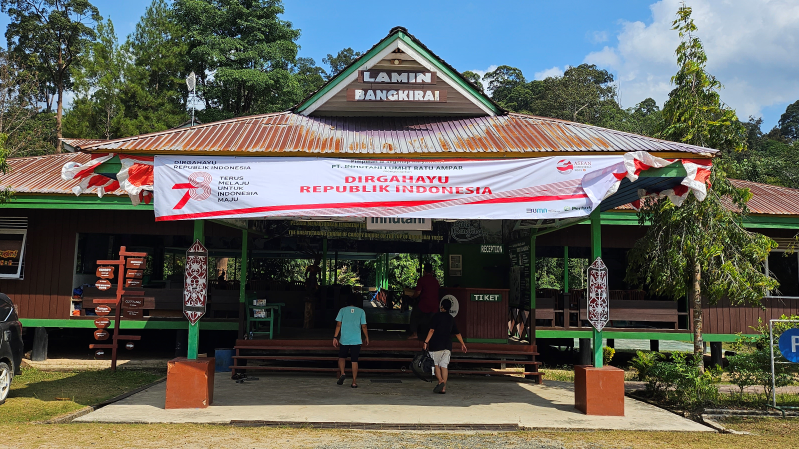GUTS TEST AT BANGKIRAI HILL
"Climb to the top of the mountain, so high." A group of junior high school students hummed. The excitement was strong among them on that sunny day. Every now and then, there was a joke.
The group of teenagers were exploring the jungle in Bukit Bengkirai Nature Park, Kutai Kartanegara, East Kalimantan. This little exploration was part of Jungle Trekking, one of a series of Conservation Camp activities, organized by the Authority of the Capital of the Archipelago (OIKN). WWF-Indonesia and several local partners supported the event on August 18-20, 2023.
During Jungle Trekking, participants must visit educational posts. Each of these stopping points has a different theme as determined by the committee. Divided into five groups, participants were accompanied by the committee to the previously assigned posts. Jungle trekking was conducted to introduce biodiversity to the participants of the conservation camp, which was attended by junior high school (SMP) and senior high school (SMA) students from Sepaku, Samboja, and West Kutai regions.
Various trees can be found in the natural forest of Bukit Bangkirai. As I follow the group, I observe the large trees that rise into the sky. Their leaves form a canopy typical of the tropical jungle of the equatorial country.
In addition, I can identify several trees such as lemongrass and rattan, as well as several fruit trees such as durian and rambutan. Accompanied by the sound of chirping birds, we walked through the forest, which was shaded as the canopy of the trees protected us from the scorching sun. After walking for about fifteen minutes, we stopped at the destination. At this educational post, WWF-Indonesia gave a briefing on plastic waste management.
Not only that, our friends also gave examples of items that can be used repeatedly to reduce the use of single-use plastics such as bamboo straws, shopping bags, drinking bottles and food boxes.
The capital city of the archipelago is currently in the process of building an Integrated Waste Management Site (TPST) 1 which is targeted to be able to process 89 tons of waste per day. As much as 8% residue (waste that is difficult to process), will later be processed into rebricks and reused.
Quoting Pungky Widiaryanto, Director of Forestry and Water Resources Utilization Development, Nusantara Capital Authority, "This Conservation Camp is held to raise awareness of the younger generation, especially junior and senior high school children because they will fill the development of IKN in the next few years. This activity is also expected to realize the mission of IKN to become a forest city."
In addition to learning about plastic waste management, there were several other educational posts, namely, posts on the introduction of protected wildlife, nature photography, orangutan food and medicinal plants, and posts on digital campaign materials.
Before we knew it, we had been in the second post for 45 minutes. We continued our journey to the gathering point at the Canopy Bridge location. The distance is not too far from our previous location, but it takes extra effort because the road contours are uphill and a little rocky.
"Just a moment, take a break to catch your breath," I said while adjusting my breathing, which was starting to become irregular. Understandably, the track I was on was no longer flat. Resting for two minutes, interspersed with sips of water, we continued our journey. Finally, we arrived at the rally point. It is located around the canopy bridge area. At this gathering point, participants discussed among their group members. They exchanged information from the five posts they had visited.
This discussion seemed to be very exciting among them. While observing the behavior of the participants, I was suddenly startled by a big voice near where I was standing. "Do you dare to go up?" Chris, who works at the WWF-Indonesia office for the West Kutai region, asked me. Chris continues to coax me into splashing across the 30-meter-high suspension bridge.
"Come on, let's go up, we've come all the way here and we won't go up," I was burned by the challenge. With my legs shaking a little, as I got higher and higher, I occasionally felt the wobbles on the stairs, but I didn't regret deciding to go up. Arriving at the top, I was mesmerized by the natural landscape of Bukit Bangkirai, which was filled with lush trees. The Bukit Bangkirai guts test trip is certainly a valuable experience that is so imprinted in my mind.





